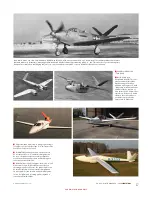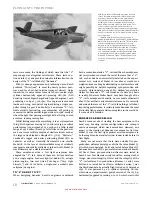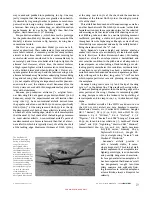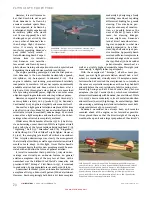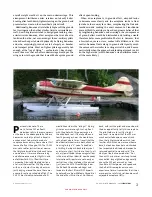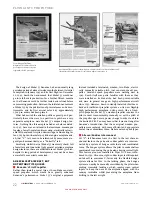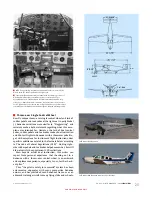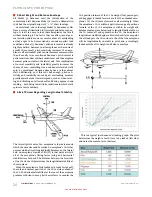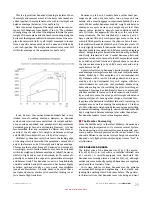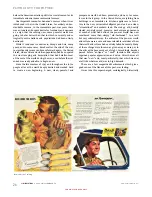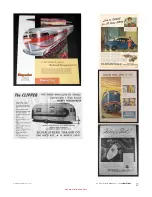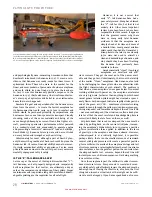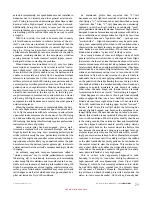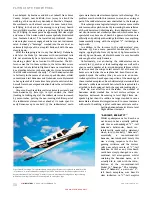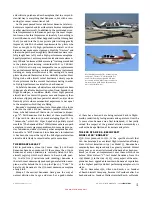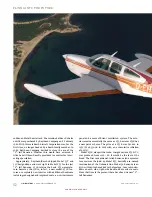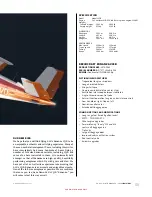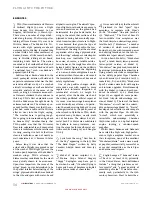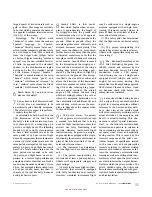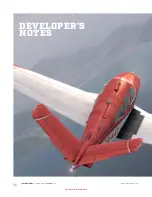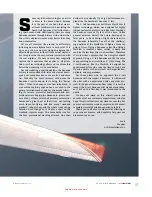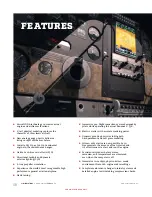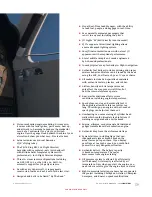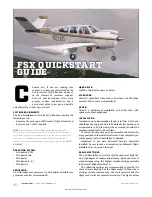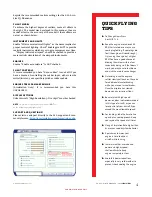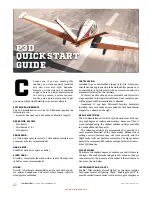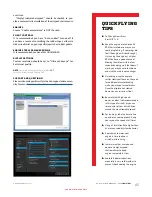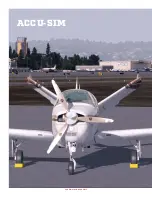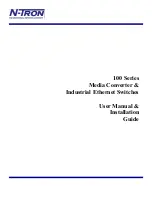
www.a2asimulations.com
ACCU-SIM V35B BONANZA
:::
A2A
SIMULATIONS
29
FOR SIMULATION USE ONLY
extend it immediately, but speed brakes are not installed in
Bonanzas nor in virtually any other general aviation air-
craft. Trying to lower the undercarriage and/or flaps to slow
down at such a high airspeed is very risky may not work.
Additionally, doing this is likely to cause just the serious
structural damage you are trying to avoid. In fact, once you
are hurtling past the redline there may be no way to avoid
a tragedy.
With this in mind, it is well to be aware that in nearly
all fatal Bonanza accidents in which a failure of the air-
craft’s structure was involved, it was determined that the
aeroplane had been flown outside its normal flight enve-
lope (i.e., flying too damn fast). In most instances these
accidents were preceded by loss of control due to the pilot’s
apparent misinterpretation of the aeroplane’s situation
causing him/her to make incorrect control inputs, exacer-
bating rather than correcting the problem.
When Bonanza was introduced in 1947, very few pilots
were trained or competent to fly in what is called “instru-
ment flight rules” (IFR) conditions, which are essentially
those in which the pilot is unable to see the horizon and is
unable to accurately and safely fly the aeroplane without
reference to instruments. At this time not even many ex-
military pilots had much IFR training or experience and the
vast majority of civilian pilots had even less. The IFR navi-
gation system, so sophisticated, efficient and ubiquitous in
modern times, was in its bare infancy in early 1950s and
virtually non- existent in the late 1940s. In that era gyro-
scopic instruments, common today and which are a crucial
aid during IFR flight, were not standard or even available
equipment in early Bonanzas and most of the other general
aviation aeroplanes.
When the weather obscures or completely hides the hori-
zon, safe flight becomes dependant upon the pilot’s abil-
ity to fly the aeroplane with sole reference to and reliance
upon what instruments may be on the panel. Yes, IFR flying
can be done without gyros and learning to do so is a part of
IFR training, but doing this effectively requires professional
instruction and lots of practice.
Unless an auto-
pilot has been engaged, even a well-
trimmed aeroplane will not maintain straight and level
flight by itself for very long. Even assuming perfectly calm
winds (which is rarely the case, particularly at altitude,) the
torque of the engine and propeller causes a steady left bank-
ing tendency which is likely to go unnoticed unless the pilot
has reference to the horizon (real or gyroscopic), the terrain
and/or notices that the aircraft’s compass heading is slowly
changing.
An ordinary magnetic compass (sometimes called a
“whisky compass” for its visible yellow/brown- coloured
lubricating oil) is notoriously inaccurate and misleading
under many flight conditions and is considered to be unre-
liable as the sole source of heading information during IFR
flight. An aeroplane out of true rigging, subtle trim inaccu-
racies, gusts of wind and/or turbulence may cause pitch and
roll changes as well, all of which may also go unnoticed by a
pilot not trained to fly in IFR conditions.
As mentioned, pilots have reported that “V”-
tail
Bonanzas are very light and sensitive in pitch to the extent
that flying a “V”- tail Bonanza has been described as being
“sportscar- like.” Also, “V”- tail Bonanzas are notoriously
unsteady in pitch and roll, tending to constantly “seek”
pitch position and laterally wander from level flight. Beech
designed Bonanza for maximum performance with little to
no considerations or compromises for flight by low- time
pilots. Whilst Bonanza’s “sportscar- like” – perhaps even
“warbird- like” – flight characteristics may be quite satis-
fying to an experienced pilot, when in IFR conditions these
characteristics are likely to create an unintended and unno-
ticed banked, nose down condition. When these are com-
bined what is called a “spiral dive” is likely to occur.
Over many decades of close and diligent study of fatal
general aviation aircraft accidents and reports from flight
instructors, the loss of a visual horizon has been cited as the
most common cause of the spiral dive phenomenon and the
fatal accident which soon and inevitably follows. It has been
determined by a number of flight instructors that if a pilot
without an instrument rating tries to turn around in IFR
conditions to fly back to clear weather he /she is likely to
mishandle the turn by not applying sufficient back pressure
on the yoke/stick, thereby allowing the nose to drop. Add to
this banked attitude the aerodynamically clean Bonanza’s
tendency to quickly accelerate to and beyond its redline
(Vne) when the nose drops, and therein exists a formula
for catastrophe that is, as is said, “Just waiting to happen.”
What happens all- too- often is this: a pilot inadvertently
and/or negligently flies into a low - visibility weather con-
dition and soon loses sight of the horizon. If not trained to
fly in IFR conditions and relying upon his/her “senses,”
11
he/she “feels” that all is well all whilst the left wing has
already slightly dropped and, because the aeroplane is no
longer flying level, the nose has also begun to drop. As men-
tioned, this situation is exacerbated if this pilot attempts a
turn in IFR conditions. What this pilot usually then hears
is the rising sound of the outside air flow and immediately
sees the airspeed indicator needle quickly rising. He/she
naturally pulls back on the control wheel to alleviate this
but, because the aeroplane’s wings are no longer level, up
elevator input only steepens the left bank which, accord-
ingly, causes the nose to drop further. Meanwhile, airspeed
continues to increase until it is quickly well past the redline
as the pilot frantically but vainly pulls back even harder on
the control wheel to slow the airplane. This continues for
only a short while until either the wings and/or tail struc-
tures fail or the aeroplane contacts the ground in a sharp
nose- down left bank at a very high speed.
This is, in fact, what apparently happened to John
Kennedy, Jr. on July 16, 1999 when his high- performance,
high-
powered and aerodynamically clean Piper PA32R
“Saratoga,” which he had recently purchased and in which
he had little flight time, crashed into the Atlantic Ocean
off the coast of Martha’s Vineyard, Massachusetts, kill-
ing all three on board (Kennedy, his wife Carolyn and his
sister- in- law Lauren Bessette). On that day, Kennedy had
Summary of Contents for BONANZA ACCU-SIM V35B
Page 1: ...A2ASIMULATIONS BONANZA ACCU SIM V35B BONANZA ...
Page 3: ...A2ASIMULATIONS BONANZA ACCU SIM V35B BONANZA ...
Page 5: ...www a2asimulations com ACCU SIM V35B BONANZA A2ASIMULATIONS 5 FOR SIMULATION USE ONLY ...
Page 27: ...www a2asimulations com ACCU SIM V35B BONANZA A2ASIMULATIONS 27 FOR SIMULATION USE ONLY ...
Page 58: ......
Page 68: ...68 A2ASIMULATIONS ACCU SIM V35B BONANZA www a2asimulations com FOR SIMULATION USE ONLY ...
Page 112: ......



